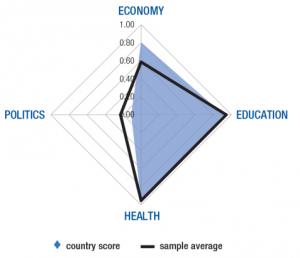Ghana shows best performance yet in Global Gender Gap Index 2015

Ghana has posted its best performance yet in the World Economic Forum’s Global Gender Gap Index which measures the gap between men and women in the areas of health, education, economic opportunity and political representation.
The country is ranked 63rd out of 145 countries, with its best ever score of 0.704 in the 2015 edition of the Index. The Index measures the size of the gender gap, between the figures 0.00 (inequality) and 1.00 (equality).
With lower scores, the country had the same rank in 2007 and a better rank of 58th in 2006 during the inception of the Index but this can be explained by the fact that the number of countries involved then was less – 115 in 2006 and 128 in 2007.
Using its own data and data from United Nations institutions such as the ILO, UNESCO, WHO and the Inter-Parliamentary Union, the World Economic Forum arrives at the rankings from sub-indexes computed for the four areas: economic participation and opportunity, educational attainment, health and survival, and political empowerment.
Indicators used in assessing economic participation and opportunity, include female labour force participation over males, wage equality, estimated earned income over males, female senior officials and managers and female professional and technical workers over males.
For the gender gap in education, female literacy over males, and female enrolment over males are used.
In health and survival, the sex ratio at birth and female health and life expectancy indicators are used, and for political empowerment, the Gender Gap Index examines females in parliament over males, and females in ministerial and head of state positions over males.
According to the World Economic Forum, the Index strictly measures the gender gap and stops short at equality. It does not award women empowerment in countries where any indicator is more inclusive for women than men.
Across the four areas of assessment, Ghana showed its strongest performance in the area of health and survival.
There was also impressive performance in education with the exception of the tertiary enrolment and the literacy rate indicators. For every 11 females in tertiary education, there are 18 males and for every 71 literate females, there are 82 males.
Economic participation follows, with some gender gaps in earned income and professional and technical work. For every 35 females in professional and technical work, there are 65 males.
Ghana’s worst performance was in political empowerment. The country’s performance though is not very far from the global average. In the last 50 years, Ghana has never had a female Head of State. The female to male ratio of Parliamentarians is 0.12 – for every 11 women in parliament, there are 89 men, and for every 23 women in ministerial positions, there are 77 men.
Iceland tops the 145-country list, followed by Norway, Finland, Sweden and Ireland in fifth.
In sixth place is Rwanda, the only African country in the top 10, followed by the Philippines, Switzerland in eighth, Slovenia and New Zealand in 10th place.
By Emmanuel Odonkor
